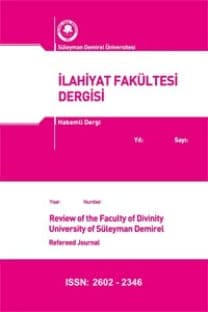OSMANLI KİTAP SANATLARINDA LA’LÎ MÜREKKEP YAPIMI
Osmanlı dönemi yazma eserleri incelendiğinde metinde en çok iki renk mürekkebin kullanıldığı görülmektedir. Elbette normal metinde ağırlıklı olarak siyah renkli is mürekkebi kullanılmıştır. Başlıklarda ise çoğunlukla kırmızı ve tonlarındaki mürekkep kullanılmıştır. Başlıklarda kullanılan kırmızı tonlarındaki renklerden daha çok bordoyu andıran renkteki mürekkep la‟lî mürekkeptir. La‟li mürekkebin temel hammaddesi Koşinil olarak da bilinen, bilimsel adı Dactylopius Coccus Costa adlı böcektir. Kaktüste yetişen böcek, güneşte kurutularak muhafaza edilir. İstanbul‟da Millet Kütüphanesi‟nde Ali Emîrî bölümünde 809 numaraya kayıtlı mecmuada yedi farklı yerde la‟lî mürekkep tarifi bulunmaktadır
Anahtar Kelimeler:
La‟lî, mürekkep, hat, yazı malzemesi, kırmızı mürekkep, yazma, Osmanlı
La’lî Ink Making in the Ottoman Book Arts
When we look at he manuscripts prepared in Ottoman period we can see that mostly two kinds of ink were used. Naturally the black coloured ink made from soot were used mostly in the regular texts. At the same time, the headlines were written mostly with red or red tone inks. The ink resembling claret colour which were used in the headlines is named “la‟lî” ink in the Ottoman period. The raw material of the “la‟lî” ink is an insect named as Dactylopius Coccus Costa and known cochineal. The insect living ot the cactuses is kept after dried under the sun. There are seven “la‟lî” descriptions on different pages in a being registered as the numbered in the Ali Emiri Section of Millet Library in Istanbul
Keywords:
La‟lî, ink, calligraphy, writing material, red ink, Ottoman, manuscript,
- Yayın Aralığı: Yılda 2 Sayı
- Başlangıç: 1994
- Yayıncı: Süleyman Demirel Üniversitesi
Sayıdaki Diğer Makaleler
KELAMDA SÜNNET KAVRAMI ÜZERİNE -Ebû Hanife’ye İsnat Edilen Risaleler Bağlamında Bir Değerlendirme
DİNÎ EPİSTEMOLOJİNİN MANTIKSAL ANALİZİNDE RASYONEL DİL İNŞASI: BÂBERTÎ ÖRNEĞİ
Hülya ALTUNYA, İsmail Latif HACINEBİOĞLU
SOSYAL KESİMLER VE SÜNNET ALGILARI ARAŞTIRMASI: MALATYA (HADİS ALAN YORUMU)
GAZZÂLÎ’NİN FİLOZOFLARI ELEŞTİRİSİNDEKİ NİHAİ HEDEFİ ÜZERİNE
Dwight GOODYEAR, Abdulkadir ÇEKİN
NEY’İN SERÜVENİ (KAMIŞLIKTAN DUDAĞA NEY)
MANTIK, EPİSTEMOLOJİ VE ARGÜMAN DEĞERLENDİRME
Robert C.-yunus Emre PİNTO-AKBAY
SOSYAL BİLİM PARADİGMALARI BAĞLAMINDA MAX WEBER’İN METODOLOJİSİ
